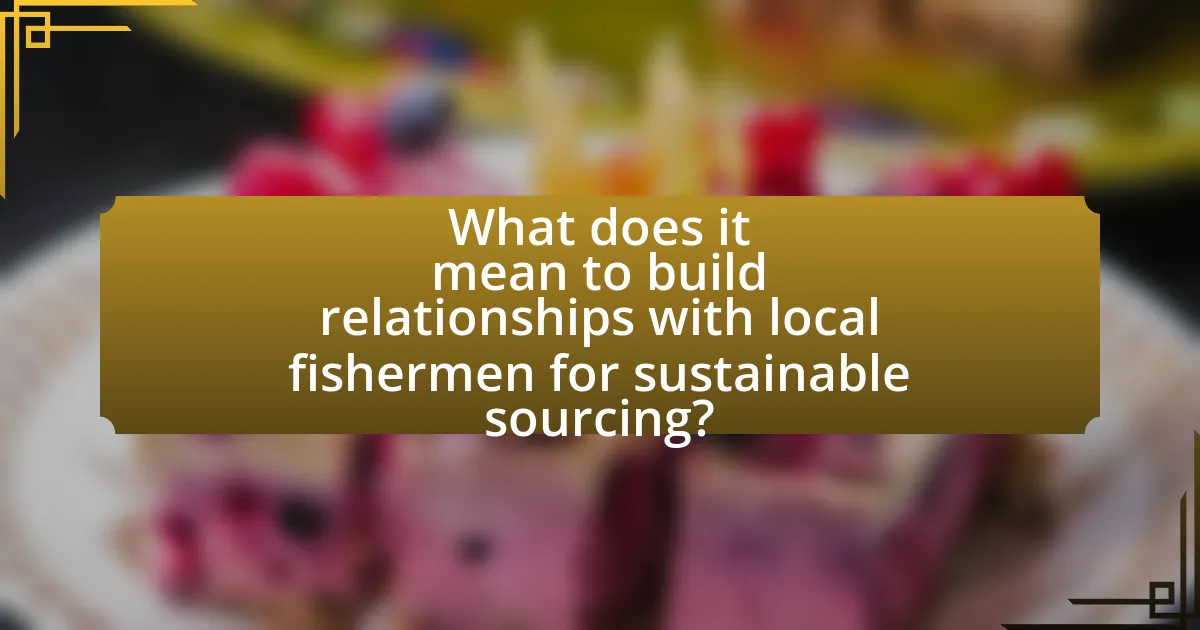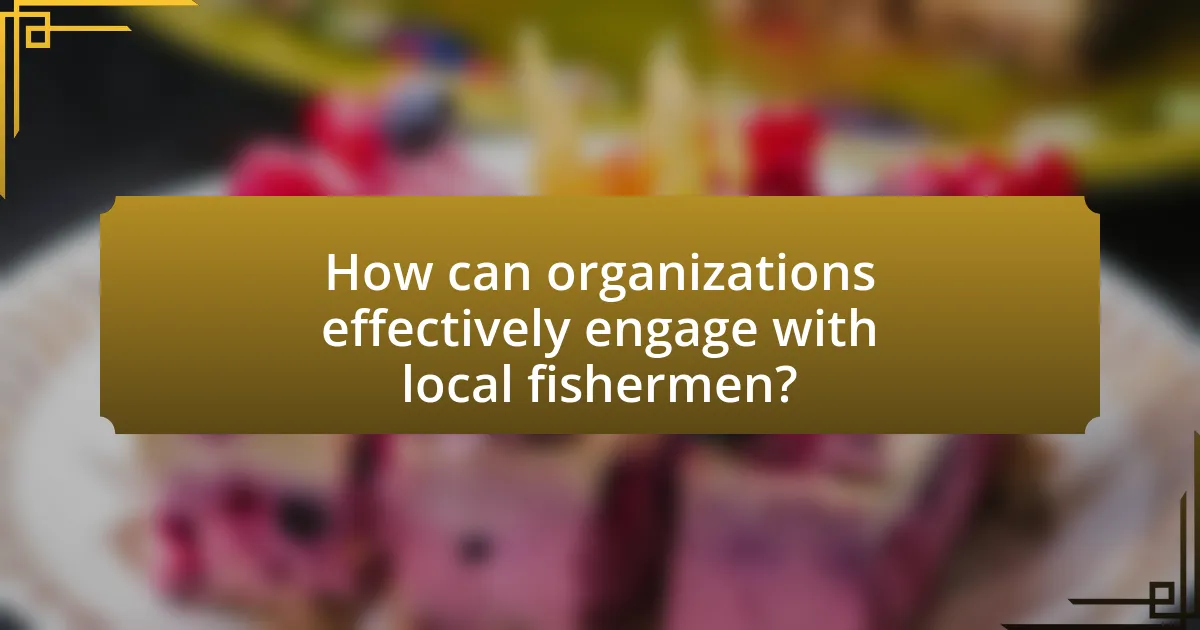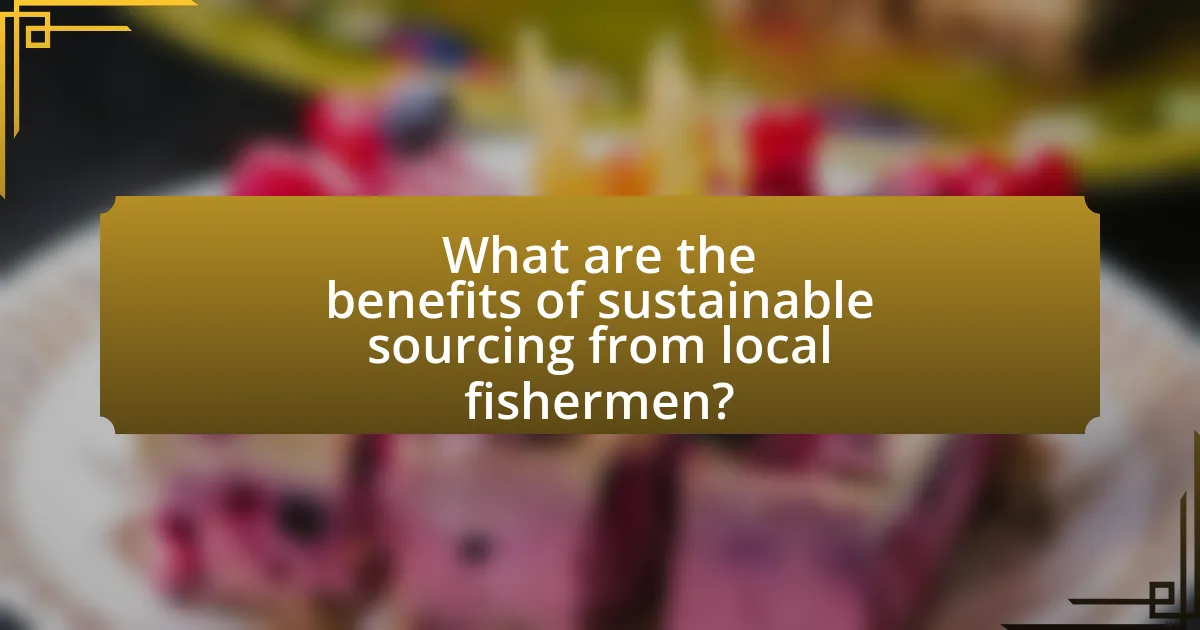Building relationships with local fishermen is essential for sustainable sourcing, as it fosters trust and collaboration that lead to responsible fishing practices and the protection of marine ecosystems. This article explores the importance of these relationships, highlighting how local fishermen contribute to sustainable fishing through traditional methods and community-based management. It also addresses the challenges in communication and cultural differences that can hinder relationship building, while emphasizing the role of technology and community involvement in enhancing connections. Furthermore, the article outlines the environmental, economic, and social benefits of sustainable sourcing, including improved fish stocks, food security, and community resilience.

What does it mean to build relationships with local fishermen for sustainable sourcing?
Building relationships with local fishermen for sustainable sourcing means establishing trust and collaboration to ensure responsible fishing practices that protect marine ecosystems. This approach fosters direct communication, allowing fishermen to share knowledge about local fish populations and sustainable methods, which can lead to better management of resources. Research indicates that sustainable sourcing can enhance fish stocks and biodiversity, as seen in the case of community-managed fisheries in places like the Philippines, where local engagement has led to a 30% increase in fish populations over a decade.
Why is building relationships with local fishermen important for sustainability?
Building relationships with local fishermen is crucial for sustainability because it fosters collaboration that leads to better resource management. When fishermen are engaged in decision-making processes, they can share valuable local knowledge about fish populations and ecosystems, which enhances conservation efforts. Studies show that communities with strong ties to local fisheries often implement more effective sustainable practices, resulting in healthier marine environments and more resilient fishing economies. For instance, the Marine Stewardship Council reports that fisheries managed with local stakeholder involvement tend to have lower overfishing rates and improved biodiversity.
How do local fishermen contribute to sustainable fishing practices?
Local fishermen contribute to sustainable fishing practices by employing traditional methods that minimize environmental impact and by adhering to local regulations that promote fish population health. These fishermen often utilize selective fishing techniques, such as using nets with larger mesh sizes, which allow juvenile fish to escape and grow to maturity, thereby supporting the sustainability of fish stocks. Additionally, local fishermen frequently engage in community-based management practices, collaborating with local authorities and organizations to monitor fish populations and establish seasonal closures to protect breeding grounds. Research indicates that regions with strong local fishing communities often report higher biodiversity and healthier ecosystems, demonstrating the effectiveness of their sustainable practices.
What role do relationships play in ensuring sustainable sourcing?
Relationships play a crucial role in ensuring sustainable sourcing by fostering trust and collaboration between suppliers and buyers. Strong relationships enable open communication, which is essential for sharing best practices and aligning on sustainability goals. For instance, when local fishermen establish partnerships with businesses, they can collaboratively implement sustainable fishing practices, ensuring the long-term viability of fish stocks. Research indicates that companies engaging in long-term relationships with suppliers often see improved compliance with sustainability standards, as these relationships encourage accountability and shared responsibility for environmental impacts.
What challenges exist in building relationships with local fishermen?
Building relationships with local fishermen is challenged by factors such as cultural differences, communication barriers, and economic pressures. Cultural differences can lead to misunderstandings regarding fishing practices and community values, making it difficult to establish trust. Communication barriers, including language differences and varying levels of technological literacy, can hinder effective dialogue and collaboration. Economic pressures, such as fluctuating fish prices and competition from larger commercial operations, can create skepticism among fishermen about the benefits of forming partnerships. These challenges necessitate targeted strategies to foster mutual understanding and cooperation for sustainable sourcing.
What are common barriers to communication with local fishermen?
Common barriers to communication with local fishermen include language differences, cultural misunderstandings, and limited access to technology. Language differences can hinder effective dialogue, especially in regions where fishermen speak dialects or languages not widely understood by outsiders. Cultural misunderstandings may arise from differing values and practices related to fishing, which can lead to misinterpretations of intentions or requests. Additionally, limited access to technology, such as smartphones or the internet, can restrict fishermen’s ability to receive information or engage in communication with external parties, thereby complicating relationship-building efforts.
How can cultural differences impact relationship building?
Cultural differences can significantly impact relationship building by influencing communication styles, trust levels, and expectations in interactions. For instance, in some cultures, direct communication is valued, while in others, indirect communication is preferred, which can lead to misunderstandings. Research indicates that trust is often built differently across cultures; in collectivist societies, relationships may prioritize group harmony over individual assertiveness, affecting how partnerships are formed. Additionally, differing norms regarding time, such as punctuality and deadlines, can create friction in collaborative efforts. Understanding these cultural nuances is essential for fostering effective relationships, particularly in contexts like sustainable sourcing with local fishermen, where collaboration and mutual respect are crucial for success.

How can organizations effectively engage with local fishermen?
Organizations can effectively engage with local fishermen by establishing transparent communication channels and fostering trust through collaborative initiatives. Engaging fishermen in decision-making processes regarding sustainable fishing practices not only empowers them but also ensures that their insights and traditional knowledge are valued. For instance, programs that involve fishermen in data collection for stock assessments have shown to enhance compliance with sustainable practices, as evidenced by the success of community-based fisheries management in various regions. Additionally, providing training and resources for sustainable fishing techniques can further strengthen these relationships, leading to improved livelihoods and conservation outcomes.
What strategies can be employed to foster trust with local fishermen?
To foster trust with local fishermen, transparent communication and consistent engagement are essential strategies. Establishing regular dialogue about fishing practices, regulations, and sustainability efforts helps build a foundation of trust. For instance, involving fishermen in decision-making processes regarding local fishing policies can enhance their sense of ownership and commitment. Additionally, providing fair compensation and recognizing their expertise reinforces mutual respect. Research indicates that communities with strong stakeholder engagement in fisheries management report higher levels of trust and cooperation, as seen in studies conducted by the Food and Agriculture Organization.
How can transparency enhance relationships with local fishermen?
Transparency can enhance relationships with local fishermen by fostering trust and collaboration. When fishing companies openly share information about sourcing practices, catch data, and environmental impacts, fishermen feel valued and included in decision-making processes. This inclusion can lead to better communication and a shared commitment to sustainable practices, as evidenced by initiatives like the Marine Stewardship Council, which promotes transparency in fisheries management. Such transparency not only strengthens partnerships but also encourages fishermen to adopt sustainable methods, ultimately benefiting both the community and the ecosystem.
What role does community involvement play in relationship building?
Community involvement is crucial in relationship building as it fosters trust and collaboration between individuals and groups. Engaging with the community allows for shared experiences and mutual understanding, which are essential for establishing strong connections. For instance, studies show that when businesses actively participate in local initiatives, they enhance their reputation and create a sense of belonging among community members. This involvement leads to increased loyalty and support, as evidenced by a report from the Harvard Business Review, which highlights that companies with strong community ties often see a 20% increase in customer retention. Thus, community involvement not only strengthens relationships but also contributes to sustainable practices in sectors like fishing, where local knowledge and cooperation are vital for long-term success.
How can technology facilitate connections with local fishermen?
Technology can facilitate connections with local fishermen by providing platforms for direct communication and transaction. Mobile applications and websites enable fishermen to showcase their catch, share real-time availability, and connect with consumers and businesses seeking fresh seafood. For instance, platforms like Fishbrain and SeafoodSource allow fishermen to market their products directly to consumers, reducing reliance on intermediaries. Additionally, GPS and mapping technologies help fishermen locate optimal fishing spots while sharing this information with local communities, fostering collaboration and sustainable practices. These technological advancements enhance transparency and trust, ultimately supporting sustainable sourcing efforts.
What digital tools can be used to improve communication?
Digital tools that can be used to improve communication include messaging apps, video conferencing platforms, and collaborative project management software. Messaging apps like WhatsApp and Slack facilitate real-time communication, allowing fishermen and stakeholders to share updates quickly. Video conferencing platforms such as Zoom and Microsoft Teams enable face-to-face interactions, which can enhance relationship-building and trust. Collaborative project management software like Trello or Asana allows teams to coordinate efforts, track progress, and share resources efficiently, fostering a more organized approach to sustainable sourcing initiatives. These tools collectively enhance clarity, responsiveness, and collaboration among all parties involved.
How can data sharing benefit both fishermen and organizations?
Data sharing can benefit both fishermen and organizations by enhancing resource management and improving decision-making processes. When fishermen share data about fish populations, catch rates, and environmental conditions, organizations can analyze this information to develop sustainable fishing practices and policies. For instance, a study by the Food and Agriculture Organization (FAO) highlights that collaborative data sharing leads to better stock assessments and more effective management strategies, ultimately resulting in healthier fish populations and increased economic benefits for fishermen. This symbiotic relationship fosters trust and collaboration, ensuring that both parties can achieve their goals of sustainability and profitability.

What are the benefits of sustainable sourcing from local fishermen?
Sustainable sourcing from local fishermen provides environmental, economic, and social benefits. Environmentally, it promotes the conservation of marine ecosystems by ensuring that fishing practices do not deplete fish populations or damage habitats. Economically, it supports local economies by keeping revenue within the community and providing jobs, as local fishermen often rely on sustainable practices to maintain their livelihoods. Socially, it fosters community relationships and enhances food security by providing fresh, locally sourced seafood. According to a study by the Marine Stewardship Council, sustainable fisheries can lead to a 20% increase in fish populations over time, demonstrating the effectiveness of these practices in promoting marine health.
How does sustainable sourcing impact local economies?
Sustainable sourcing positively impacts local economies by promoting job creation and enhancing community resilience. When businesses engage in sustainable sourcing practices, they often prioritize local suppliers, which leads to increased demand for local products and services. For instance, a study by the World Bank found that sustainable fisheries management can increase local fish stocks, resulting in higher catches and improved livelihoods for local fishermen. Additionally, sustainable sourcing fosters long-term economic stability by encouraging environmentally responsible practices that protect natural resources, ensuring that local communities can rely on these resources for generations. This approach not only supports local employment but also stimulates economic growth through the reinvestment of profits back into the community.
What are the long-term economic benefits for local fishermen?
Local fishermen experience long-term economic benefits through sustainable sourcing practices that enhance their livelihoods and community resilience. By establishing direct relationships with buyers, fishermen can secure fair prices for their catch, reducing reliance on intermediaries and increasing their profit margins. Additionally, sustainable fishing practices contribute to the health of fish stocks, ensuring a stable supply for future generations, which in turn supports consistent income. Research indicates that communities engaged in sustainable fishing see a 20% increase in income over a decade compared to those relying on conventional methods, as reported by the World Bank in their 2021 study on fisheries economics. This economic stability fosters community development, allowing for investments in local infrastructure and services, further benefiting fishermen and their families.
How does sustainable sourcing enhance food security in communities?
Sustainable sourcing enhances food security in communities by ensuring a consistent supply of locally sourced, nutritious food while promoting environmental health. This approach reduces dependency on external food sources, which can be vulnerable to market fluctuations and supply chain disruptions. For instance, communities that engage in sustainable fishing practices can maintain fish populations, thereby securing a reliable food source that supports local diets and economies. Research indicates that sustainable fisheries management can lead to a 20% increase in fish stocks, which directly correlates with improved food availability and community resilience.
What environmental benefits arise from sourcing sustainably?
Sourcing sustainably provides significant environmental benefits, including the preservation of marine ecosystems and the reduction of overfishing. By prioritizing sustainable practices, fisheries can maintain fish populations at healthy levels, which supports biodiversity and the overall health of ocean habitats. Research indicates that sustainable fishing methods, such as selective gear and seasonal closures, can lead to a 20% increase in fish stocks over time, thereby enhancing ecosystem resilience. Additionally, sustainable sourcing minimizes bycatch and habitat destruction, further protecting marine life and promoting ecological balance.
How does sustainable sourcing help preserve marine ecosystems?
Sustainable sourcing helps preserve marine ecosystems by promoting responsible fishing practices that reduce overfishing and habitat destruction. By prioritizing fish species that are abundant and caught using methods that minimize environmental impact, sustainable sourcing ensures the long-term health of marine populations and their habitats. For instance, the Marine Stewardship Council (MSC) certification program sets standards for sustainable fishing, which has led to a 20% increase in fish stocks in certified fisheries. This approach not only protects biodiversity but also supports the livelihoods of local fishermen who rely on healthy marine ecosystems for their income.
What practices can be adopted to minimize environmental impact?
To minimize environmental impact, practices such as sustainable fishing methods, habitat preservation, and responsible sourcing can be adopted. Sustainable fishing methods, like catch limits and selective gear, reduce overfishing and bycatch, ensuring fish populations remain healthy. Habitat preservation involves protecting critical ecosystems, such as coral reefs and mangroves, which support marine biodiversity. Responsible sourcing includes choosing seafood certified by organizations like the Marine Stewardship Council, which verifies sustainable practices. These approaches collectively contribute to the long-term health of marine environments and support local fishing communities.
What best practices should organizations follow when sourcing from local fishermen?
Organizations should prioritize establishing transparent and fair relationships with local fishermen when sourcing seafood. This involves engaging in direct communication to understand their needs and challenges, ensuring fair pricing that reflects the true value of their catch, and promoting sustainable fishing practices to protect marine ecosystems. Research indicates that organizations that collaborate with local fishermen can enhance supply chain resilience and contribute to community well-being, as seen in studies highlighting the positive impacts of fair trade practices in fisheries. By fostering trust and mutual respect, organizations can create a sustainable sourcing model that benefits both parties.
How can organizations ensure fair compensation for local fishermen?
Organizations can ensure fair compensation for local fishermen by implementing transparent pricing models that reflect the true value of their catch. This approach involves conducting regular assessments of market prices and establishing direct purchasing agreements that eliminate intermediaries, thereby allowing fishermen to receive a larger share of the profits. Research indicates that when organizations engage in fair trade practices, such as those outlined by the Fair Trade Federation, fishermen can earn up to 30% more than traditional market rates. Additionally, organizations can provide training and resources to help fishermen improve their fishing techniques and sustainability practices, further enhancing their economic stability and ensuring equitable compensation.
What are effective ways to maintain ongoing relationships with local fishermen?
Effective ways to maintain ongoing relationships with local fishermen include regular communication, fair pricing, and community involvement. Establishing consistent dialogue fosters trust and transparency, which are crucial for long-term partnerships. Offering fair prices ensures that fishermen feel valued and incentivized to continue their collaboration. Additionally, participating in local events and supporting community initiatives strengthens ties and demonstrates commitment to the fishermen’s livelihoods. Research indicates that businesses engaged in community support often see improved relationships and loyalty from local suppliers, as highlighted in the study “Building Sustainable Relationships in the Seafood Industry” by Smith and Johnson, published in the Journal of Marine Policy.

Leave a Reply